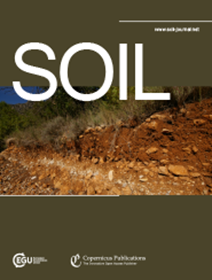免耕覆盖残茬提高土壤物理性质,降低土壤抗渗透能力——东北软土地区的比较研究
IF 4.3
2区 农林科学
Q1 SOIL SCIENCE
引用次数: 0
摘要
摘要。东北地区是中国重要的粮食生产基地。然而,长期的集约化耕作破坏了原生土壤结构,导致土壤退化,产生过多的作物残茬,制约了农业的可持续发展。为了应对这些挑战,一项田间试验评估了四种机械化耕作-播种方法:精准耕作(PTS)、精准耕作(RTS)、免耕播种(NTS)和免耕覆盖和播种(NTMS)。本研究通过分析土壤渗透阻力(SPR),系统评估了这些做法对土壤压实的影响,并进一步研究了它们对土壤含水量(SWC)和土壤容重(SBD)的影响。结果表明,NTMS显著增加了SWC,而NTS比其他做法导致更高的SBD和SPR。相对于NTS, PTS和RTS都能改善SWC,并比NTS或NTMS更有效地减少SBD。在所有实践中,SPR在大豆生长周期中表现出一致的趋势,在结荚期达到峰值。NTMS通过优化土壤物理特性,从而提高土壤质量,减缓黑土的退化过程,优于其他做法。总的来说,在玉米-大豆轮作系统中实施NTMS为解决东北软泥区玉米秸秆过剩和土壤退化提供了可行的解决方案。本文章由计算机程序翻译,如有差异,请以英文原文为准。
No-tillage with Stubble Mulching Enhances Soil Physical Properties and Reduces Soil Penetration Resistance: A Comparative Study in Mollisol Region of Northeast China
Abstract. The mollisol region of Northeast China constitutes a critical grain production base. However, prolonged intensive farming has disrupted native soil structures, driving soil degradation and generating excessive crop residues that constrain sustainable agricultural development. To address these challenges, a field experiment evaluated four mechanized tillage-sowing practices: Plow Tillage with Precise Sowing (PTS), Rotary Tillage with Precise Sowing (RTS), No-Tillage Sowing (NTS), and No-Tillage with Stubble Mulching and Sowing (NTMS). This study systematically assessed the impacts of these practices on soil compaction through analysis of soil penetration resistance (SPR), while further examining their effects on soil water content (SWC) and soil bulk density (SBD). Results demonstrated that NTMS significantly increased SWC, whereas NTS resulted in higher SBD and SPR than other practices. Both PTS and RTS improved SWC relative to NTS and reduced SBD more effectively than NTS or NTMS. Across all practices, SPR exhibited consistent trends during the soybean growth cycle, peaking at the podding stage. NTMS outperformed alternative practices by optimizing soil physical properties, thereby enhancing soil quality and slowing degradation processes in the black soil. Collectively, NTMS implemented within a maize-soybean rotation system offers a viable solution to address maize straw surplus and soil degradation in Northeast China's mollisol region.
求助全文
通过发布文献求助,成功后即可免费获取论文全文。
去求助
来源期刊

Soil
Agricultural and Biological Sciences-Soil Science
CiteScore
10.80
自引率
2.90%
发文量
44
审稿时长
30 weeks
期刊介绍:
SOIL is an international scientific journal dedicated to the publication and discussion of high-quality research in the field of soil system sciences.
SOIL is at the interface between the atmosphere, lithosphere, hydrosphere, and biosphere. SOIL publishes scientific research that contributes to understanding the soil system and its interaction with humans and the entire Earth system. The scope of the journal includes all topics that fall within the study of soil science as a discipline, with an emphasis on studies that integrate soil science with other sciences (hydrology, agronomy, socio-economics, health sciences, atmospheric sciences, etc.).
 求助内容:
求助内容: 应助结果提醒方式:
应助结果提醒方式:


